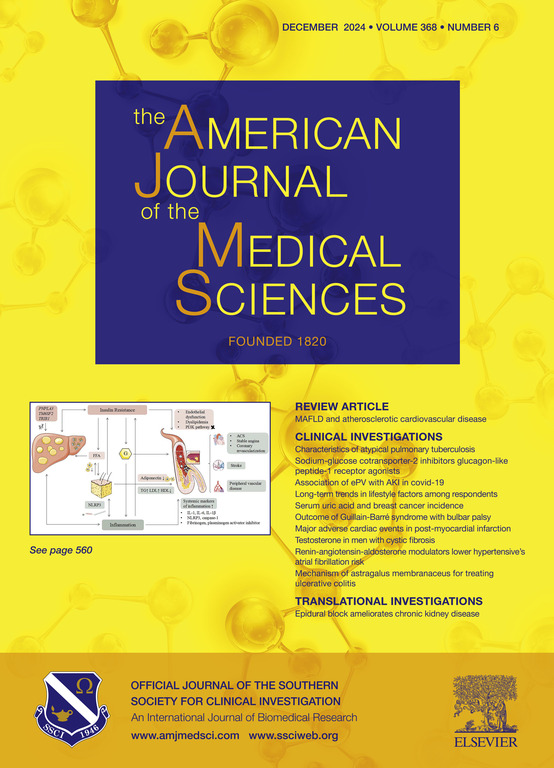Transcatheter edge-to-edge repair in patients with mitral annular calcification: A systematic review and meta-analysis
IF 1.8
4区 医学
Q2 MEDICINE, GENERAL & INTERNAL
引用次数: 0
Abstract
Background
Mitral annular calcification (MAC) is common in patients with functional mitral regurgitation undergoing transcatheter edge-to-edge mitral valve repair (TEER). However, the safety and effectiveness of TEER systems in patients with MAC is poorly understood.
Methods
We systematically reviewed multiple online databases to identify studies that reported outcomes in patients undergoing TEER with underlying moderate/severe MAC versus those with no/mild MAC. Random-effect model meta-analysis at a 95 % confidence interval was done via Cochrane Review Manager 5.4.
Results
A total of 6 studies with a pooled 2808 patients (no/mild MAC: 84.5 % vs moderate/severe MAC: 15.5 %) were included. Compared to those with no/mild MAC, patients undergoing TEER with moderate/severe MAC have an insignificant trend towards a lower immediate procedural success (OR: 0.62, 95 % CI: 0.37 – 1.04, p = 0.07). After one year of TEER, the two groups had similar rates of repeat mitral valve intervention or surgery (OR: 1.67, 95 %CI: 0.92 – 3.05, p = 0.09), sustained clinical improvement (NYHA ≤ 2) (OR: 0.86, 95 %CI: 0.64 - 1.15, p = 0.30), and heart failure re-admission (OR: 0.84, 95 %CI: 0.52 - 1.36, p = 0.48). All-cause mortality was, however, higher in the moderate/severe MAC patients (OR: 1.82, 95 %CI: 1.15 – 2.86, p = 0.01).
Conclusions
TEER appears safe and effective in carefully selected patients with significant MAC. A standardized selection algorithm is needed to identify MAC patients that would benefit most from TEER.
二尖瓣环钙化患者的经导管边缘到边缘修复:系统回顾和荟萃分析。
背景:二尖瓣环钙化(MAC)在功能性二尖瓣反流接受经导管边缘到边缘二尖瓣修复(TEER)的患者中很常见。然而,TEER系统在MAC患者中的安全性和有效性尚不清楚。方法:我们系统地回顾了多个在线数据库,以确定报告TEER中潜在中度/重度MAC患者与无/轻度MAC患者预后的研究。通过Cochrane Review Manager 5.4进行95%置信区间的随机效应模型荟萃分析。结果:共纳入6项研究,共纳入2808例患者(无/轻度MAC: 84.5% vs中/重度MAC: 15.5%)。与无/轻度MAC患者相比,接受TEER治疗的中度/重度MAC患者的即时手术成功率较低(OR: 0.62, 95% CI: 0.37 - 1.04, p=0.07)。TEER治疗一年后,两组重复二尖瓣介入或手术的比率相似(or: 1.67, 95%CI: 0.92 - 3.05, p=0.09),持续临床改善(NYHA≤2)(or: 0.86, 95%CI: 0.64 - 1.15, p=0.30),心力衰竭再入院(or: 0.84, 95%CI: 0.52 - 1.36, p=0.48)。然而,中/重度MAC患者的全因死亡率更高(OR: 1.82, 95%CI: 1.15 - 2.86, p = 0.01)。结论:在精心挑选的MAC显著患者中,TEER是安全有效的。需要一种标准化的选择算法来确定从TEER中获益最多的MAC患者。
本文章由计算机程序翻译,如有差异,请以英文原文为准。
求助全文
约1分钟内获得全文
求助全文
来源期刊
CiteScore
4.40
自引率
0.00%
发文量
303
审稿时长
1.5 months
期刊介绍:
The American Journal of The Medical Sciences (AJMS), founded in 1820, is the 2nd oldest medical journal in the United States. The AJMS is the official journal of the Southern Society for Clinical Investigation (SSCI). The SSCI is dedicated to the advancement of medical research and the exchange of knowledge, information and ideas. Its members are committed to mentoring future generations of medical investigators and promoting careers in academic medicine. The AJMS publishes, on a monthly basis, peer-reviewed articles in the field of internal medicine and its subspecialties, which include:
Original clinical and basic science investigations
Review articles
Online Images in the Medical Sciences
Special Features Include:
Patient-Centered Focused Reviews
History of Medicine
The Science of Medical Education.

 求助内容:
求助内容: 应助结果提醒方式:
应助结果提醒方式:


